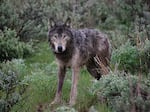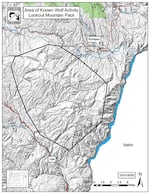The Oregon Department of Fish and Wildlife has approved killing up to four uncollared wolves in Baker County, where the Lookout Mountain wolf pack attacked four cows in 14 days last month.
The state has confirmed that wolves killed or injured the four cows from July 14-26 and it approved a kill permit for the affected livestock producer.
State rules allow for lethal removal of wolves when repeated attacks present a significant risk to livestock and when nonlethal methods of managing wolves, such as electric fencing or hazing, haven’t worked to stop the attacks.

A wolf collared by Oregon Department of Fish and Wildlife in 2009. Radio collars allow the state to track the location of known wolves. Wolves with radio collars are not typically eligible for lethal removal.
Oregon Department of Fish and Wildlife
A kill permit authorizes the livestock producer or their agents to shoot a wolf from the ground. ODFW may also assist and may shoot from the air.
ODFW spokeswoman Michelle Dennehy said she doesn’t know yet if the state will be assisting with this kill permit.
She said lethal removal has been approved about a half-dozen times since 2009 when the wolves were first re-established in Oregon. The last time the state-authorized lethal removal was in June 2018, after the Pine Creek wolf pack killed two calves and injured four more in Baker County.
“Lethal removal is allowed where we have chronic depredation, which is specifically defined in the rules, and when nonlethal methods are being used and are not working,” Dennehy said.
The area authorized for lethal removal is northeast of Durkee, in Baker County, and includes a mix of private land and public land where the affected livestock producer has a grazing permit. The permit expires on Aug. 21 or when livestock are removed from the area.
Under the Oregon Wolf Conservation and Management Plan, ranchers need to use non-lethal methods of deterring wolves and remove any bone piles or carcasses that could attract them before lethal control can be used.

Oregon Department of Fish and Wildlife has authorized the lethal removal of up to four wolves from the area outlined on this map in Baker County.
Oregon Department of Fish and Wildlife
Dennehy said her agency found the livestock producer whose cows were attacked has been using non-lethal measures for years and since January has increased the human presence in the area, checked the cows at night, moved calving cows to safer locations and started using radio-activated guard boxes that sound an alarm when a collared wolf is nearby.
According to ODFW, the livestock producer has also been checking with ODFW on the location of collared wolves and moving cows based on that information, as well as hazing wolves using firearms and removing injured livestock from pastures to prevent conflicts with wolves.
“Once we get an area of known wolf activity, there are certain preventive measures we recommend, nonlethal measures that aren’t required but are important,” Dennehy said. “For us to consider lethal control, some of those need to be in effect.”
Both of the adult wolves in the Lookout Mountain pack have radio collars that allow the state to track them, and neither of those wolves is eligible for lethal removal. The breeding pair had two pups last year, Dennehy said, and the state documented another seven pups in May.
As of April, the state had 173 wolves in 22 identified packs. State counts show the population grew 9.3% over the past year and has increased every year since 2009.
“We’re still seeing that Northeast Oregon has the majority of the state’s wolf population, but we are seeing dispersal happening,” Dennehy said. “We’ve seen wolves moving to other parts of the state and to California. That’s a good sign that there’s connectivity.”
Conservation groups are critical of state policies allowing for lethal removal and they argue gray wolves still need protection as the species is still recovering. Earlier this year, five wolves were found dead in Eastern Oregon, and ODFW reported nine wolf fatalities statewide last year, including three that were illegally poached.
Gray wolves were removed from the federal Endangered Species List in January, and that allowed ODFW to take over the management of their population.
On Thursday, a coalition of 70 groups filed a formal petition to re-list the gray wolf as an endangered species throughout the West, including Oregon and Washington.
Erik Molvar, executive director of Western Watersheds Project, one of the groups that filed the petition, said his group is particularly concerned about state-level rules in Idaho and Montana that call for killing large portions of the existing wolf populations.
“Wolves remain completely absent from suitable habitats or perilously close to extinction in many western states,” he said. “In order to return the wolf and restore the balance of nature, it is necessary to apply federal protections that supersede anti-wolf state politics that push wolf populations toward extinction rather than recovery.”
